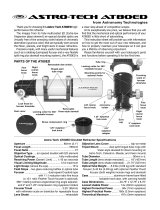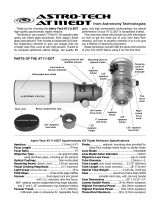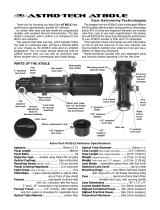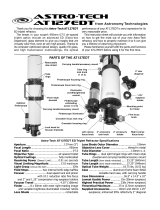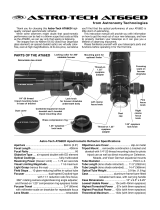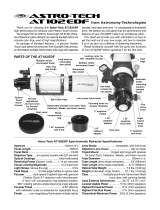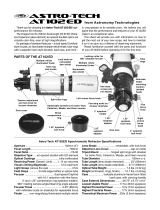Page is loading ...

astr o-tech AT80EDT
from Astronomy Technologies
Thank you for choosing our Astro-Tech AT 80 EDT high-
performance apochromatic triplet ED refractor.
While some observers might doubt that you can get
apochromatic performance from an 80mm scope that is
as inexpensive as the Astro-Tech AT80 EDT, we can say
only that seeing is believing.
The images from its fully-multicoated 560mm f/7 ED
(Extra-low Dispersion element) premium Ohara glass
triplet optics are virtually color-free, even at high
Aperture .............................................. 80mm (3.1”)
Focal Length ...............................................560mm
Focal Ratio ........................................................ f/7
Objective Type.............. triplet using Ohara ED glass
Optical Coatings ........................... fully multicoated
Resolving Power (Dawes’ Limit) ....... 1.45 arc seconds
Visual Limiting Magnitude .............. 12.0 maximum
Light Grasp (versus the eye) .............................. 131x
Field Stops ......... glare-reducing baffle in optical tube
Focuser ............................. dual-speed Crayford-type
with 11:1 reduction ratio fine focus;
2” and 1.25” compression ring eyepiece holders;
360° rotating camera angle/observing angle adjuster
Focuser Travel ................................... 3.1” (80mm),
millimeter scale on drawtube for repeatable focus
Lens Shade ............................................ retractable
magnifications. At its low price, we believe you will find
that the visual and photographic performance of your
AT 80 EDT triplet is little short of remarkable.
This instruction sheet will provide you with information
on how to get the most out of your new refractor, and
how to properly maintain your scope so it can give you a
lifetime of observing enjoyment.
Please familiarize yourself with your telescope’s parts
and functions before operating it for the first time.
Astro-Tech AT80EDT Apochromatic Triplet Refractor Specifications
Objective Lens Cover ......................... slip-on metal
Tripod Mount .. removable combination L-bracket and
dovetail for direct mounting on Celestron, Meade,
and Vixen equatorial mounts; two 1/4”-20 thread
mounting holes for photo tripod use
Tube Diameter ...................................... 90mm o. d.
Tube Length (lens shade retracted)..... 17.75” (451mm)
Tube Length (lens shade extended) ... 20.25” (514mm)
Optical Tube Weight................... 6.75 lbs. (3.07 kg)
Case ............................. aluminum-frame foam-fitted
lockable hard case, with carrying handle
Case Dimensions .................22.25” x 12.75” x 8.25”
Lowest Usable Power ............ 14x (40mm eyepiece)
Highest Terrestrial Power ....... 80x (7mm eyepiece)
Highest Practical Power ........ 140x (4mm eyepiece)
Theoretical Maximum ........... 187x (3mm eyepiece)
Retractable
dew shield
Lock knob for
focuser drawtube
1/4”-20 thread
tripod mounting holes
in base of reversible
bracket
Combined equatorial mount
dovetail and L-bracket
tripod mounting shoe
PARTS OF THE AT80EDT
Left coarse
focus knob
Fine
focus
knob
Focusing
scale on
focuser
drawtube
2” eyepiece
lock knob
Dust cover
1.25” eyepiece
lock knob
Brass compression ring
Mounting point for
optional finder
1.25”
eyepiece
lock knob
2”
eyepiece
holder
Locking collar for 360°
rotatable focuser
1.25” eyepiece
lock knob
Fine
focus
knob
Right
coarse
focus
knob
1.25”
eyepiece
adapter
1.25”
eyepiece
adapter
Right
coarse
focus
knob

astro -tech
www.astronomytechnologies.com
from Astronomy Technologies, PO Box 720013, Norman, OK 73070
© 2007 by Astronomy Technologies Specifications, features, and descriptions are effective 7/1/2007, but are subject to correction and/or modification without notice and/or obligation.
Your Astro-Tech AT80EDT ED triplet refractor is usable for day
and night viewing, simply by adding a star diagonal and eyepiece.
Any brand of eyepiece can be used, from a 40mm for the lowest
practical magnification (14x) to a 3mm (187x) for high power use. A
2” compression ring eyepiece holder on the focuser drawtube and a
supplied 1.25” eyepiece adapter let you use either 2” or 1.25” star
diagonals and eyepieces with no other adapter needed.
The focal length of the AT80EDT is ideal for low to medium power
wide-angle views of nebulas, open star clusters, large galaxies, and
comets. Crisp views of the Moon and planets are also routine at mag-
nifications of 112x to 187x when seeing conditions permit.
To calculate the magnification of your telescope and eyepiece com-
bination, divide the telescope focal length in mm by the eyepiece
focal length in mm. For example, a 5mm eyepiece in the AT80EDT
will give you a magnification of 112x (560mm/5mm = 112).
Astronomical Observing: The theoretical maximum usable power
available from this telescope is 187x, although this requires a 3mm
eyepiece that provides a narrow and very dim 0.43mm exit pupil. A
more practical maximum magnification for astronomical viewing with
the AT80EDT would be 140x, using a 4mm eyepiece. Keep in mind
that seeing conditions play an important role in how high a magnifi-
cation you can use on any given night. Only very good seeing condi-
tions (clear skies and calm air) will support viewing at 187x. Under
less than ideal conditions, lower powers in the 80x to 112x range
provide more consistently usable and pleasing images.
The widest possible field of view with a 1.25” eyepiece is about 3°,
which can be achieved with a 14x (40mm) Plössl eyepiece.
While the AT80EDT has not been specifically designed for astro-
photography, it does an outstanding job as a wide-field astrograph
for casual 35mm and CCD imaging. A chrome thumbscrew under the
focuser lets you lock in a sharp focus for photography.
The focuser can be rotated a full 360° for the best photographic
composition, or to put your star diagonal and eyepiece into the most
comfortable observing position. To rotate the focuser, loosen the dark
green ribbed lock ring on the telescope barrel by turning it to the left.
Adjust the focuser to the desired angle, then turn the lock ring back
to the right to lock the focuser at the new angle.
Terrestrial Observing: The AT80EDT works well for daytime
birding, nature studies, sweeping the landscape from the home with
a view, etc. It is also a very good 560mm (11.2x) f/7 telephoto lens
for terrestrial photography. Generally speaking, the maximum usable
daytime power with any terrestrial scope is about 1x per mm of aper-
ture (80x with a 7mm eyepiece on the AT80EDT). Attempts to push
the daytime power beyond 80x often magnify the heat waves, dust,
and “mirage” in our atmosphere to the point where the images be-
come blurry and unusable. A 22x (25mm) to 62x (9mm) eyepiece is
usually more satisfying for everyday terrestrial use than an 80x.
Mounting the AT80EDT: A stable tripod or astronomical mount
is essential for best viewing. The AT80EDT is light enough to be used
on any good quality camera tripod with an 8 to 10 pound payload
capacity, using either of the two 1/4”-20 thread holes in the scope’s
L-shaped mounting bracket. The front mounting hole provides a bet-
ter balance when the scope is used with a 1.25” star diagonal and
eyepiece. The rear mounting hole is better suited for use with a heavier
2” diagonal and eyepiece, or a camera.
The bracket can also be unbolted, rotated 180°, and reinstalled on
the scope. This moves the balance point further back on the scope
body to help balance very heavy 2” accessories and cameras.
The L-bracket is sized and shaped like the dovetail used to connect
optical tubes to the Celestron Advanced Series; Meade LXD-75; and
Vixen Sphinx, Porta, and Great Polaris astronomical mounts. This dove-
tail shape allows you to install the AT80EDT directly on any of these
mounts with no other adapter required.
The L-bracket can be totally removed from the AT80EDT by undo-
ing the recessed hex-head bolts holding it to the scope body. This
allows you to install the scope on other telescope mounts by using a
pair of optional Astro-Tech 90mm split mounting rings.
Optional Astro-Tech Accessories: Astro-Tech makes 1.25” and
2” star diagonals with state-of-the-art 99% reflectivity dielectric coat-
ings that nicely complement the performance of the AT80EDT. These
diagonals are available from your Astro-Tech dealer to provide the
maximum possible reflectivity and planetary detail. An Astro-Tech 45°
viewing angle image-erecting 1.25” diagonal is available for terres-
trial observing. An inexpensive non-magnifying Astro-Tech illuminated
multireticle finder is also available for your AT80EDT.
Caring for Your Scope Optics: Never store the telescope in a
damp or humid environment. Avoid leaving it in a hot environment
(exposed to direct sunlight on a window sill, in a car trunk, etc.) If
you must store it in high humidity conditions, put a few packets of
desiccant (silica gel or the equivalent, available from most camera
stores) in with the telescope to absorb excess moisture. If not prop-
erly stored in a humid environment, the telescope may develop mil-
dew which can damage the optics.
If dew has formed on the scope after a night of observing, allow
the optics to air dry at room temperature before putting the lens
cover on the scope and storing it away.
If the front lens surface becomes dusty, smeared, or shows finger-
prints or any other surface build-up, clean the lens using the follow-
ing technique. First, gently blow away any surface dust or particles
with a clean air blower (a child’s ear syringe or a photographer’s
camel’s hair brush with attached blower bulb, for example). Using
canned or compressed air is not recommended, as the propellant in
the can may spit out and leave difficult-to-remove deposits on the
lens. Also, the expanding compressed air drops in temperature as it
leaves the can. The cold air coming out of the tiny tube that most
compressed air cans use to direct the air flow has been known to chill
a lens to the point of spalling chips of glass off the lens if pointed at
the same spot on the glass for too long.
Second, moisten a cloth with a few drops of a photographic-quality
optical cleaning solution designed for multicoated camera and bin-
ocular lenses. A well-worn cotton handkerchief works well and Zeiss
and Kodak both make suitable fluids. Do not drip the cleaning fluid
directly on the lens. Use the barely damp (not wet) cloth to gently
wipe the lens surface clean, turning the cloth frequently to always
keep a clean portion of the cloth in contact with the lens. Blot the lens
dry with a dry portion of the cleaning cloth or a separate cloth. Start
with a clean cloth each time cleaning is needed.
Avoid overcleaning your scope. The multicoatings on the lens are
quite hard and durable. However, frequent overzealous cleaning can
scratch the coatings if all the dust particles (which are often tiny
flecks of windborne rock) are not removed before you start pushing a
damp cloth around the lens surface. A few specks of debris on the
lens will not be visible in your images. They are not in the focal plane
and don’t block enough light to measure, let alone be seen. Clean
your optics only when absolutely necessary. If you take proper care
of your scope, cleaning should rarely be needed.
Caring for Your Scope Finish: The finish of the AT80EDT is a
durable baked automotive paint with anodized components. The scope
can become smudged with fingerprints during use, but these will not
harm the finish. A clean soft cloth slightly dampened with plain water
(or a little moisture from your breath and a quick wipe with a clean
handkerchief) is generally enough to remove fingerprints. Avoid harsh
chemical cleaners or organic solvents like benzene, alcohol, etc., as
these may ruin the finish. They can certainly affect the optical coat-
ings if they accidentally drip or splash on the objective lens.
Never use the telescope in the rain or in conditions where it may
get wet. The telescope is not waterproof. If the telescope accidentally
gets caught in the rain, immediately wipe off all water using a clean
and dry soft cloth. If the telescope gets totally soaked in water, or
submerged, immediately contact your dealer for service instructions.
Do not disassemble or attempt to repair your telescope yourself, as
this violates the terms of the limited product warranty, and negates
any guarantee.
Caution! Never directly view the Sun with your telescope!
Never aim your AT80EDT at the Sun without having a professionally-
manufactured solar filter mounted over the objective lens. Viewing
the Sun through the scope without the proper protection for even a
moment may result in permanent severe damage to your eyes, and
can even cause blindness. Contact your Astro-Tech dealer if you are
interested in purchasing a compatible professional solar filter.
/
